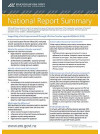In 2013 the Education Review Office (ERO) evaluated the quality of teacher appraisal systems in schools using online surveys of principals and information from 200 school reviews. This report presents the findings of ERO’s evaluation of schools’ approaches to teacher appraisal.
Methodology
Key evaluative question
The overarching question ERO sought to answer was How effectively do schools’ appraisal systems contribute to improvements in teacher capability and student outcomes? This was explored by investigating factors that enhanced or hindered the implementation of a robust appraisal system.
Sources of information
Information for this report was drawn from three sources:
- an online survey of a random sample of principals about teacher appraisal (204 principals, 69 percent response rate)
- an investigation of a range of performance management practices in 173 primary schools in Term 1, 2013
- an investigation of a range of performance management practices in 27 secondary schools in Term 1, 2013.
What did the online survey ask?
The online survey gathered detailed information from principals about the schools’ documented policies and procedures, monitoring processes, training, sources of information and advice, and appraisal practices. It also asked them to report how effective they thought their appraisal system was in improving teacher practices and outcomes for all students.
The demographic characteristics of responding schools were generally similar to those of all schools nationally.
What schools were involved in the investigations?
Appraisal process and outcomes in 173 primary schools were evaluated during their regular education reviews. The primary schools’ investigations did not include any schools with an early return of one-to-two years stated in their previous ERO review report. Schools where the previous ERO review stated a return time of four-to-five years were also not reviewed because they were not due for a review in 2013.
As only a few secondary schools were scheduled for review in Term 1, a sample of 27 secondary schools was selected for an on-site investigation by an ERO team who visited solely to review a range of employment responsibilities. Analysis of the most recent ERO review reports of these schools showed that their overall performance was more effective than secondary schools nationally. The next ERO review for one-third of these schools’ was in four-to-five years compared with 15 percent nationally. No secondary school had an early ERO return. The secondary schools visited therefore are probably more effective than all secondary schools nationally, and the secondary school figures presented in this report may give a more positive picture than would be true for all secondary schools.
Reviewers interviewed principals and teachers and examined documentation to make judgements about appraisal effectiveness.
The investigated schools’ demographic characteristics were generally similar to those of all schools nationally.
See the following appendices for more information:
- Appendix 2: Principals’ survey - appraisal of teachers
- Appendix 3: Appraisals - evaluative questions and indicators
- Appendix 4: Demographics of the schools investigated and those that responded to the survey.
Key Results
Findings from the on-site reviews
- Just over 20 percent of primary schools and four percent of secondary schools had high quality appraisal systems that supported schools to improve teacher capability and student outcomes.
- Another 35 percent of primary and 37 percent of secondary schools had compliant appraisal systems.
- Forty-five percent of primary schools and 59 percent of secondary schools had limited appraisal systems.
Findings from the surveys
- Thirty percent of the principals surveyed reported their appraisal systems were either very effective or effective at improving the quality of the full range of key teaching and student outcomes. Another 30 percent said their appraisal systems were either very effective or effective at improving the quality of most of the key teaching and student outcomes. (See Appendix 2 for this range.)


